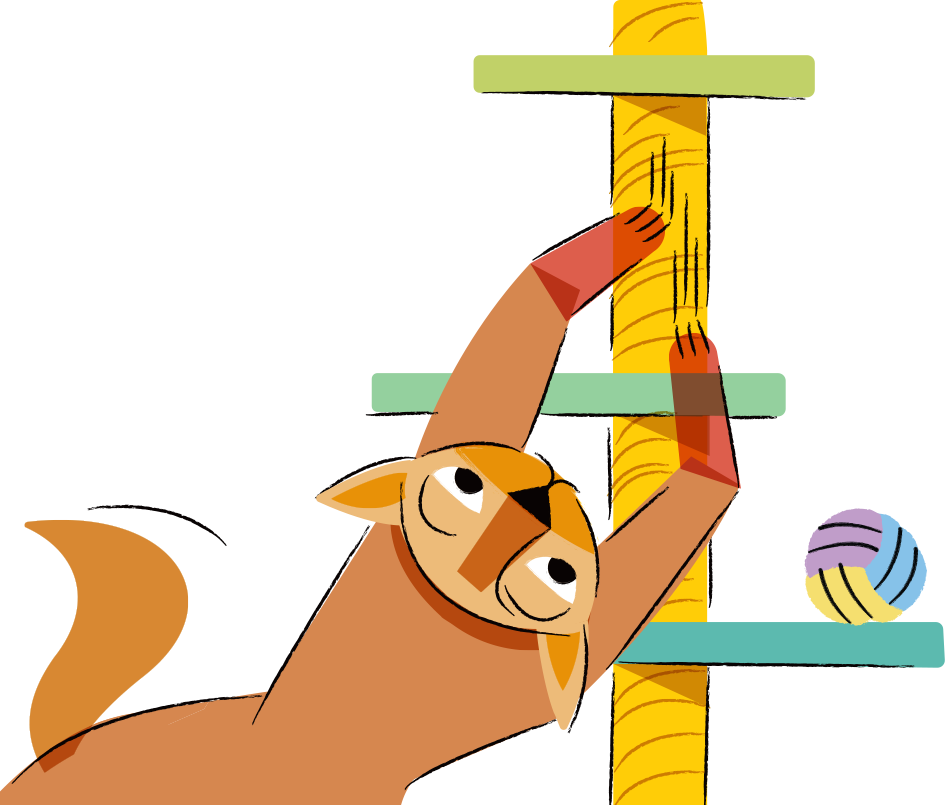
Toys, Towers and Tricks
Environmental Enrichment Makes for Happy Pets
Owners are responsible for creating the best possible environments for pets for their physical and mental health.


lion on the African savannah spends his days socializing, sleeping, and searching for food. The day-to-day existence of the feline that lounges in your living room may look a little different, but your cat and her wild brethren have similar physical and mental needs, regardless of their environments.
Since this is true across species, it is no surprise that the concept of environmental enrichment—which began with animals maintained in zoos and aquariums—is also important for the health and happiness of our pets. Enrichment ensures the welfare of animals in environments created and controlled by humans. It reduces stress by providing for psychological and behavioral needs as determined by the natural history of the species, essentially addressing how animals fill their time.
“When it comes to captive animals, including our dogs and cats, we manage every aspect of their lives,” said Dr. Liz Stelow, chief of the Behavior Service at the UC Davis veterinary hospital. “We create the environment for them and choose who they live with and what activities they have available. This can cause problems if you don’t thoughtfully manage those options.”

The Behavior Service often sees behavioral problems in animals that live in unenriched situations. Owners are responsible for creating the best possible environments for pets for their physical and mental health. Proactive approaches can reduce, or even eliminate, undesirable behaviors.
Food First
Whether your pet is a rabbit or a rooster, the way to its heart is probably through its stomach. Fortunately, meals are a great place to start implementing environmental enrichment strategies.
“There is no good reason for a dog or cat to eat meals out of a bowl,” said Stelow. “There are food toys, puzzles, and interactive training options for feeding. If you put down a bowl of food and your animal inhales it, you have missed an opportunity to enrich their lives. Satiety does not come from inhaling food and moving on. It comes from acquiring, manipulating, and consuming the food.”
There is no good reason for a dog or cat to eat meals out of a bowl. Satiety does not come from inhaling food and moving on. It comes from acquiring, manipulating, and consuming the food.
—Dr. Liz Stelow
This is especially true for cats, whose natural behavior is to hunt for their food. Consider feeding approaches that mimic hunting behaviors. This can be as simple as putting food in a tower, or as complex as an interactive puzzle board.
Food toys are available for a variety of species, including birds, exotics, and livestock. Be sure the toy is the correct size for your pet, and discard it when it is worn or broken. Rotate toys to extend their life and keep your animal interested. Homemade food toys and puzzles are also easy to construct. Just be sure to consult with your veterinarian to ensure that they are safe for your pet to use.

Get Going
Food is often linked to activity, and this is an area where animals kept in cages and indoor cats typically lack adequate enrichment. “Owners should be playing with their cats much more than they do,” said Stelow. “Indoor cats should have vertical spaces they can explore and opportunities to look out the window. The environment we provide for our indoor cats is all they get.”
We take our dogs for walks, but may not realize that walks are an opportunity for enrichment. While trying to cram a walk in between work and the kids’ soccer practice, it is easy to become goal oriented. You may say to yourself, “We are going to walk around the block and be back in ten minutes.”
According to Stelow, taking the dog for a walk ought to be about the dog. If they want to stop and smell the neighbors’ roses for five minutes, let them. Allowing your dog to explore different locations and walk on different surfaces are also ways to provide enrichment.
Activity is especially important for animals kept in cages, which includes many exotics.
Activity is especially important for animals kept in cages, which includes many exotics. Cage furniture needs to be safe and appropriate for natural behaviors. Small mammals, such as mice and hamsters, may benefit from a wheel, for example. However, it is important to note that a solid surface wheel is safer than one made of wire which can injure their feet.
For large, grazing animals, such as horses, food and activity are intertwined. We often underestimate how long our hooved animals should take to eat. Their food is notoriously poor in nutrition, so they should eat a lot of it over an extended period. Time on pasture is the best enrichment. If that is not possible, it is important to create activities for them that use up the time budget they would spend grazing. Otherwise, they come up with things to fill their time, which is often the root of undesirable, repetitive behaviors.

Teach Tricks
Interactive training, i.e. teaching new tricks, is good for your pet’s health and well-being and benefits your relationship with them. However, keep in mind that it is not about perfection. In fact, it is all right if they never become very good at these skills. The process of expanding the pet’s mind and repertoire is as important as physical exercise.
Training is not just for dogs.
Training is not just for dogs. Rabbits, chickens, horses, rodents, and many other species can be trained to manipulate objects or complete obstacle courses. Remember that training sessions should be fun for you and your pet. Avoid situations that make your animal frustrated or fearful.

Bring in a Buddy
Environmental enrichment also includes addressing your pets’ social needs. This varies depending on the species, as well as the individual animal. Hamsters are territorial and are usually best living alone, whereas guinea pigs are social and happiest with some company. Your dog may appreciate a play date, but that is not something we usually do with cats.
Fostering is a great way to see if the fit is right for everyone.
If you are thinking of adding another pet to the household, Stelow highly recommends fostering first. It is a great way to see if the fit is right for everyone before making a lifelong commitment.
“We have seen older dogs turn around cognitively when a younger pet is added to the household,” said Stelow. “It can take some pressure off the owners because they don’t have to be everything to their pet anymore. However, it can be tricky, so fostering takes away the uncertainty.”
Keep It Interesting
Enrichment will vary by species, individual, and even by season. It is important to mix things up to keep it interesting for you and your pet. Once you figure out what your pet likes, try some variations on a theme. Try freezing a KONG® with some peanut butter to keep your dog occupied in hot weather or put some cabbage in a hanging basket for your chickens.
“Studies in zoos have shown that enrichments can be really successful, but you have to shake it up sometimes,” said Stelow. “There are online resources with countless ways to mix things up. Just know that not every animal is going to like everything and not everything on the internet is safe.”
Whichever approaches to environmental enrichment you and your pet choose, check with your veterinarian to ensure that they are safe and healthy for your animal.
Behavior Service at UC Davis
Veterinarians in the Behavior Service at the UC Davis Veterinary Hospital specialize in animal behavior in a variety of species, enabling them to consider possible medical conditions that may affect behavior. Our veterinary behaviorists work with shelters, rescue organizations, laboratories, sanctuaries, farms, zoos, and more to address individual as well as population behavioral health concerns.
Phone: 530-752-1393
Email: vetbehavior@ucdavis.edu
(Appointments cannot be made via email.)
